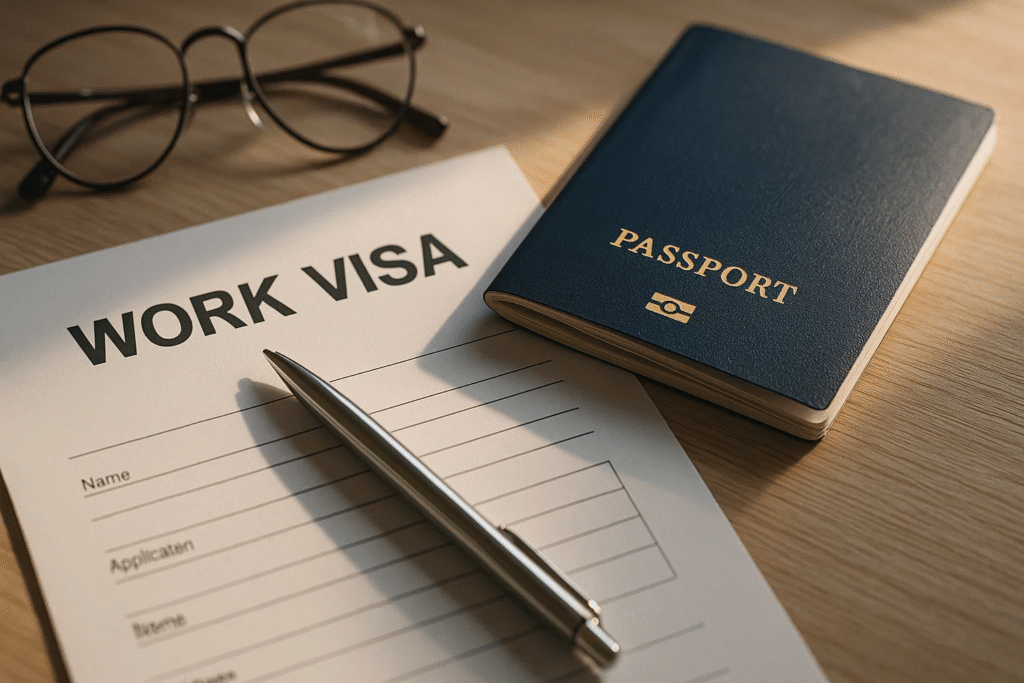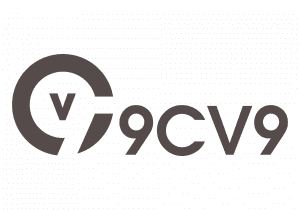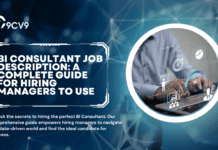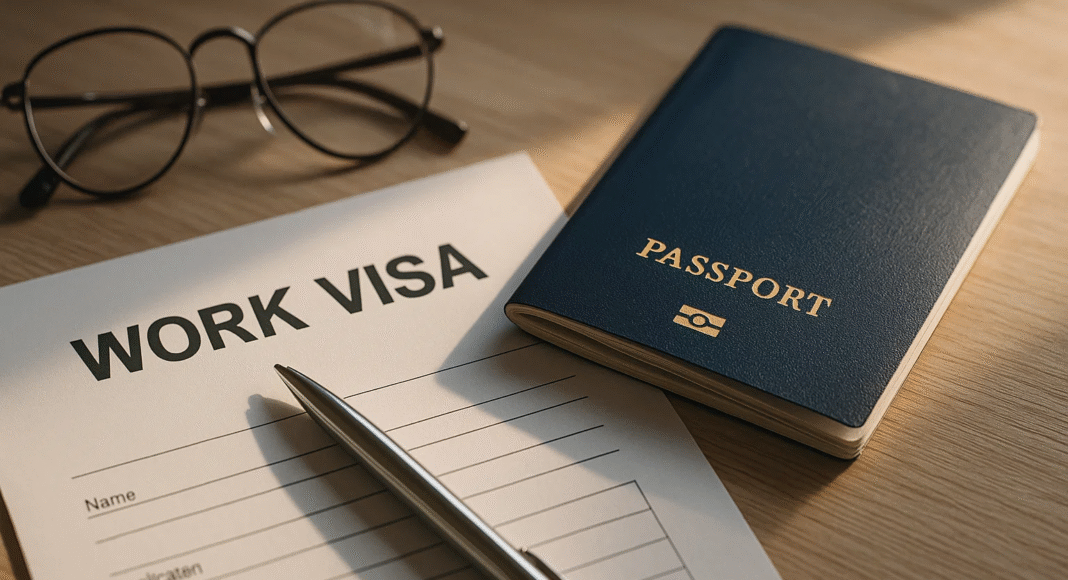Key Takeaways
- Work visas provide legal authorization for foreign nationals to work abroad, with specific types like specialty, seasonal, and investor visas.
- The application process requires employer sponsorship, accurate documentation, and compliance with immigration regulations.
- Work visa holders gain labor protections, social benefits, and potential pathways to permanent residency or citizenship.
In today’s globalized economy, work visas have become essential instruments for professionals, skilled workers, and entrepreneurs seeking employment opportunities beyond their home countries. A work visa is a government-issued authorization that allows a foreign national to enter, reside, and work legally in a specific country for a predetermined period. Unlike general tourist visas, which only permit temporary visits, work visas are specifically designed to regulate foreign employment, ensuring compliance with local labor laws and protecting both employers and employees. Understanding how work visas function is critical for anyone aiming to pursue an international career, relocate for professional growth, or expand business operations across borders.

Work visas serve multiple purposes. They enable countries to attract foreign talent to address skills shortages in critical industries such as information technology, healthcare, engineering, and finance. They also provide a structured framework that ensures employers hire international workers legally while maintaining fair labor standards for all employees. For individuals, obtaining a work visa not only legitimizes their employment but also provides access to benefits such as social security, healthcare, and sometimes pathways to permanent residency. However, the process of obtaining a work visa varies significantly depending on the destination country, the type of employment, and the applicant’s qualifications.
Typically, the work visa application process involves several stages, including securing an employment offer, employer sponsorship, submission of relevant documentation, and approval by the host country’s immigration authorities. The requirements can differ widely, ranging from proof of specialized skills or educational credentials to labor market tests that ensure no local workers are available for the position. Additionally, work visas may be categorized into temporary, long-term, or permanent, each with its own set of eligibility criteria, duration, and limitations on job mobility.
Navigating the complexities of work visas can be challenging, particularly for first-time applicants or those targeting countries with strict immigration policies. Factors such as visa caps, processing times, and changes in immigration regulations can significantly impact the timeline and success of an application. Despite these challenges, obtaining a work visa offers substantial professional and personal advantages, from gaining international experience and higher earning potential to expanding global networks and enhancing career prospects.
This comprehensive guide explores what a work visa is, the different types available, how the application process works, and the rights and responsibilities of visa holders. It also provides insights into the global landscape of work visas, highlighting country-specific policies and trends that influence international employment. By understanding the intricacies of work visas, job seekers, professionals, and businesses can make informed decisions, optimize their chances of approval, and effectively plan their international career or business expansion.
Before we venture further into this article, we would like to share who we are and what we do.
About 9cv9
9cv9 is a business tech startup based in Singapore and Asia, with a strong presence all over the world.
With over nine years of startup and business experience, and being highly involved in connecting with thousands of companies and startups, the 9cv9 team has listed some important learning points in this overview of What is a Work Visa & How Does It Work.
If you are looking for a job or an internship, click over to use the 9cv9 Job Portal to find your next top job and internship now.
Email [email protected] now for career and job finding services.
Or hope over to 9cv9 Job Placement Services for Professionals to learn how to get hired and find a high-paying job.
What is a Work Visa & How Does It Work
- Understanding Work Visas
- Types of Work Visas
- The Application Process
- Rights and Responsibilities of Work Visa Holders
- Global Perspectives on Work Visas
1. Understanding Work Visas
Definition and Purpose
A work visa is a legal authorization granted by a government that allows a foreign national to enter and work in a country for a specified duration. Unlike tourist or visitor visas, work visas are directly tied to employment, ensuring that foreign workers are legally permitted to contribute to the local labor market. The primary purpose of work visas is to balance the demand for skilled labor with national employment priorities. By regulating foreign employment, countries can protect domestic workers while attracting specialized talent that fills critical skill gaps in sectors such as technology, healthcare, finance, and engineering.
Work visas also serve as a protective mechanism for both employees and employers. Employees gain legal recognition for their work, access to labor rights, and often eligibility for social security and healthcare benefits. Employers benefit from a structured process to hire qualified international talent, ensuring compliance with labor laws and reducing the risk of penalties or legal complications.
Temporary and Permanent Work Visas
Work visas are generally categorized into temporary and permanent types, each designed to meet specific employment and immigration objectives.
Temporary Work Visas
- Issued for a defined period, often tied to a particular job or employer.
- Commonly used for project-based work, seasonal employment, or specialized assignments.
- Example: H-1B visa in the United States allows foreign professionals in specialty occupations to work for up to three years, with the possibility of extension.
Permanent Work Visas
- Provide long-term or indefinite employment authorization, often forming a pathway to permanent residency or citizenship.
- Typically require higher qualifications, employer sponsorship, or a significant contribution to the host country’s economy.
- Example: Canada’s Express Entry system allows skilled workers to obtain permanent residency based on points awarded for experience, education, and language proficiency.
Comparison Matrix: Temporary vs Permanent Work Visas
| Feature | Temporary Work Visa | Permanent Work Visa |
|---|---|---|
| Duration | Limited (e.g., 1–5 years) | Indefinite or long-term |
| Employer Dependency | Often tied to a specific employer | May allow multiple employers |
| Pathway to Residency | Limited or conditional | Usually leads to permanent residency |
| Eligibility Criteria | Specialized skills or temporary demand | High qualifications, points-based systems |
| Renewal Options | Possible extensions | Not typically needed |
Key Benefits of Work Visas
- Legal Authorization: Grants the right to work and reside in the host country.
- Protection Under Labor Laws: Ensures compliance with wage standards, working hours, and employment conditions.
- Access to Social Services: In many countries, work visa holders can access health insurance, retirement benefits, and tax systems.
- Career Advancement Opportunities: Enables international experience, skill development, and global networking.
Global Examples of Work Visa Programs
United States – H-1B Visa
- Purpose: To attract highly skilled professionals in specialty occupations.
- Requirements: A job offer in a relevant field, typically requiring a bachelor’s degree or higher.
- Duration: Initial period of three years, extendable to six years.
Canada – Temporary Foreign Worker Program (TFWP)
- Purpose: Addresses labor shortages in agriculture, healthcare, and hospitality.
- Requirements: Employer must demonstrate the need for a foreign worker through a labor market impact assessment.
- Duration: Varies depending on the job contract.
Australia – Temporary Skill Shortage Visa (Subclass 482)
- Purpose: Allows employers to address skill shortages when qualified local workers are unavailable.
- Requirements: Job offer in an eligible occupation; relevant qualifications and experience.
- Duration: Two to four years, depending on the stream.
Illustrative Chart: Work Visa Process Overview
Step 1 – Job Offer and Employer Sponsorship
Step 2 – Application Submission with Supporting Documents
Step 3 – Review and Approval by Immigration Authorities
Step 4 – Visa Issuance and Entry into Host Country
Step 5 – Employment and Compliance with Visa Conditions
Understanding the categories, purposes, and benefits of work visas is fundamental for both employers and prospective international employees. By analyzing country-specific programs, duration options, and eligibility requirements, individuals can make informed decisions about pursuing employment abroad. Employers can strategically plan for workforce needs while ensuring compliance with immigration regulations, making work visas a critical component of global talent mobility.
2. Types of Work Visas
Specialty Occupation Visas
Specialty occupation visas are designed for professionals whose work requires specialized knowledge, advanced education, or unique skills. These visas are most common in industries such as information technology, engineering, healthcare, and finance. Countries offering specialty occupation visas often require proof of a job offer and relevant academic or professional qualifications.
- United States – H-1B Visa
- Purpose: Allows U.S. employers to hire foreign workers in specialty occupations.
- Requirements: Job must require a bachelor’s degree or higher in a specific field; applicant must have equivalent education or experience.
- Duration: Initially three years, extendable up to six years.
- Example: A software engineer from India securing an H-1B visa to work for a technology company in Silicon Valley.
- Australia – Temporary Skill Shortage Visa (Subclass 482)
- Purpose: Fills skill shortages where local workers are unavailable.
- Requirements: Employer nomination, relevant qualifications, and work experience in an eligible occupation.
- Duration: Two to four years, depending on the specific stream.
Intra-Company Transfer Visas
Intra-company transfer visas allow employees of multinational companies to relocate temporarily to a branch or subsidiary in another country. These visas are intended to facilitate knowledge transfer, managerial assignments, or specialized training.
- United States – L-1 Visa
- Purpose: Enables international companies to transfer executives, managers, or employees with specialized knowledge to U.S. offices.
- Requirements: Employee must have worked for the company abroad for at least one year within the last three years.
- Duration: One to three years, extendable up to seven years for executives and managers.
- Example: A marketing manager working in a European branch of a multinational corporation transferring to the U.S. headquarters.
- United Kingdom – Intra-Company Transfer Visa
- Purpose: Transfers skilled employees within a global company to UK offices.
- Requirements: Sponsorship by the employer, evidence of relevant skills, and salary thresholds.
- Duration: Up to five years for senior roles.
Seasonal and Temporary Worker Visas
Seasonal and temporary worker visas cater to industries with cyclical or short-term labor needs, including agriculture, hospitality, and tourism. These visas are strictly tied to the duration of employment.
- United States – H-2A and H-2B Visas
- Purpose: H-2A for agricultural work, H-2B for non-agricultural temporary work.
- Requirements: Job offer, labor certification demonstrating lack of domestic workers, and temporary employment nature.
- Duration: Typically up to one year, with possible extensions.
- Example: A farm worker from Mexico hired for the harvest season in California under an H-2A visa.
- Canada – Seasonal Agricultural Worker Program (SAWP)
- Purpose: Provides temporary labor for agricultural work during peak seasons.
- Requirements: Employer sponsorship and compliance with employment standards.
- Duration: Seasonal contracts, renewable for multiple years.
Entrepreneur and Investor Visas
Entrepreneur and investor visas are designed to attract foreign investment and stimulate economic growth by enabling business owners or investors to establish and manage companies in the host country.
- United States – E-2 Investor Visa
- Purpose: Allows foreign nationals from treaty countries to invest a substantial amount in a U.S. business.
- Requirements: Significant investment, active business management, and creation of employment opportunities.
- Duration: Initial two years, renewable indefinitely while business operations continue.
- Example: An entrepreneur from France establishing a tech startup in New York.
- United Kingdom – Innovator Visa
- Purpose: For experienced entrepreneurs seeking to establish innovative businesses in the UK.
- Requirements: Endorsement by a recognized body, investment of at least £50,000, and scalable business plan.
- Duration: Three years, with a pathway to permanent residency.
Comparison Table of Work Visa Types
| Visa Type | Purpose | Typical Duration | Key Requirements | Example Application |
|---|---|---|---|---|
| Specialty Occupation Visa | Hire skilled professionals | 2–6 years | Job offer, relevant degree or experience | H-1B for IT professional in U.S. |
| Intra-Company Transfer Visa | Relocate employees within multinational firm | 1–7 years | Employment history with company, sponsorship | L-1 for manager moving to U.S. HQ |
| Seasonal/Temporary Worker Visa | Short-term labor for specific industries | Up to 1 year | Job offer, labor market certification | H-2A for farm workers in U.S. |
| Entrepreneur/Investor Visa | Encourage foreign investment | 2–5 years (renewable) | Investment, business plan, active management | E-2 visa for U.S. startup founder |
Visual Flowchart: Work Visa Selection Process
Step 1 – Determine Purpose of Employment (Skill-based, Transfer, Seasonal, Investment)
Step 2 – Identify Eligible Visa Category Based on Country Regulations
Step 3 – Review Requirements (Education, Experience, Investment, Employer Sponsorship)
Step 4 – Prepare and Submit Application with Supporting Documents
Step 5 – Attend Interview or Review (If Required)
Step 6 – Visa Issuance and Commencement of Employment
Understanding the different types of work visas is crucial for both employers and prospective employees to navigate international employment opportunities effectively. Selecting the appropriate visa type ensures legal compliance, facilitates smooth transitions for workers, and optimizes benefits for businesses seeking to attract or relocate global talent.
3. The Application Process
Overview of Work Visa Applications
The work visa application process is a structured and often multi-step procedure designed to ensure that foreign nationals meet all legal and employment requirements of the host country. It typically involves employer sponsorship, submission of supporting documents, review by immigration authorities, and approval before entry is authorized. Understanding the detailed steps, requirements, and timelines of the application process is crucial for both applicants and employers to prevent delays, refusals, or legal complications.
Employer Sponsorship and Job Offer
- Importance of Employer Sponsorship
- Most work visas require an employer to formally sponsor the foreign worker, acting as a legal representative in the application process.
- Sponsorship ensures the applicant’s employment is genuine, meets regulatory standards, and aligns with labor market conditions.
- Example: For the United States H-1B visa, the sponsoring employer must submit Form I-129 petition to the U.S. Citizenship and Immigration Services (USCIS) to confirm the job offer and the candidate’s qualifications.
- Components of Employer Sponsorship
- Official job offer letter specifying position, salary, and duration.
- Proof of the company’s legitimacy, such as business registration documents and tax records.
- Labor market assessments or certifications (if required) demonstrating that local workers cannot fill the role.
Documentation and Forms
- Common Documents Required
- Passport valid for the duration of the visa.
- Educational credentials, certifications, and professional licenses.
- Employment letters detailing previous experience and roles relevant to the visa category.
- Financial statements or proof of investment for entrepreneur or investor visas.
- Country-Specific Forms
- United States: Form I-129 (H-1B, L-1), Form I-140 (employment-based permanent residency).
- Canada: IMM 1295 (Work Permit Application), LMIA (Labor Market Impact Assessment).
- Australia: Form 482 Nomination and Visa Application forms.
Review and Processing
- Initial Review by Immigration Authorities
- Applications are assessed for completeness, authenticity, and compliance with eligibility criteria.
- Background checks and security clearances may be conducted to verify applicant information.
- Decision Timelines
- Processing times vary by country, visa type, and application volume.
- Example: H-1B visa applications in the United States are typically processed within 3–6 months, whereas Canada’s Temporary Foreign Worker Program may take 1–4 months depending on the employer’s location and labor market assessment requirements.
Interview and Additional Verification
- Visa Interviews
- Many countries require applicants to attend an interview at an embassy or consulate to confirm eligibility and intent to work.
- Topics often include job role, qualifications, and planned duration of stay.
- Additional Verification
- In some cases, applicants may be asked to provide biometric data, health examinations, or police clearance certificates.
- Example: For the UK Skilled Worker Visa, applicants must provide a tuberculosis test result if coming from certain countries.
Approval and Issuance
- Visa Approval
- Once the application is approved, the applicant is issued a visa stamp or electronic authorization allowing entry and legal employment.
- Approval letters often outline visa validity, permitted employers, and restrictions such as duration or job role limitations.
- Post-Issuance Compliance
- Visa holders must comply with employment terms, maintain legal status, and avoid unauthorized work.
- Extensions or changes in employment typically require updated applications or notifications to immigration authorities.
Application Process Matrix
| Stage | Applicant Responsibility | Employer Responsibility | Example Requirement |
|---|---|---|---|
| Job Offer & Sponsorship | Accept job offer, gather credentials | Submit sponsorship petition | Form I-129 for H-1B |
| Documentation Preparation | Provide passport, education, experience documents | Ensure documents meet regulatory standards | Labor Market Impact Assessment (Canada) |
| Submission & Review | Submit completed application | Track application status | USCIS or consulate review |
| Interview & Verification | Attend interview, provide biometric data if needed | Support employee with documentation | UK Skilled Worker Visa interview |
| Approval & Entry | Receive visa, enter host country legally | Notify HR and ensure compliance | Visa stamp, electronic travel authorization |
Visual Flowchart: Work Visa Application Process
Step 1 – Secure Job Offer and Employer Sponsorship
Step 2 – Collect Required Documents (Passport, Credentials, Employment Proof)
Step 3 – Employer Submits Petition or Nomination to Immigration Authority
Step 4 – Initial Review and Background Verification
Step 5 – Applicant Attends Interview and Provides Additional Evidence (if needed)
Step 6 – Visa Approval and Issuance
Step 7 – Entry into Host Country and Commencement of Employment
Step 8 – Compliance with Employment Terms and Visa Conditions
Understanding the application process in detail equips applicants with the knowledge to prepare accurate submissions, avoid common errors, and meet deadlines. Employers, in turn, can streamline sponsorship responsibilities, ensure regulatory compliance, and facilitate timely employment of foreign talent. Proper preparation at each stage enhances the likelihood of approval and minimizes the risk of delays or denials.
4. Rights and Responsibilities of Work Visa Holders
Legal Employment Authorization
- Right to Work Legally
- Work visa holders are legally authorized to work in the host country for the employer and position specified in the visa.
- Engaging in unauthorized employment can result in visa revocation, fines, or deportation.
- Example: A software engineer on an H-1B visa in the United States is only permitted to work for the sponsoring employer. Taking another job without proper authorization violates visa conditions.
- Employment Limitations
- Many work visas are employer-specific or role-specific, meaning the visa holder cannot switch employers without filing for a visa transfer or amendment.
- Some countries, such as Canada and Australia, allow open work permits under specific conditions, providing flexibility in employment.
Access to Benefits
- Labor Rights and Protections
- Work visa holders are typically entitled to the same labor rights as domestic employees, including fair wages, regulated working hours, safe working conditions, and anti-discrimination protections.
- Example: In Germany, employees on a work visa benefit from statutory minimum wage regulations and mandatory workplace insurance.
- Social Security and Healthcare
- Visa holders may be eligible for social security, health insurance, and retirement contributions depending on the country’s policies.
- Example: In Australia, employees on a subclass 482 visa contribute to superannuation funds and may access Medicare if eligible.
- Tax Obligations
- Work visa holders must comply with local tax laws, including income tax, social contributions, and reporting obligations.
- Example: A skilled worker in the United States must file federal and state tax returns even if their visa is temporary.
Duration, Renewal, and Extensions
- Duration of Stay
- Work visas are valid for a specific period and may require renewal or extension depending on the visa type.
- Example: The UK Skilled Worker Visa is typically valid for up to five years, after which the holder may apply for an extension or permanent residency.
- Extension and Renewal Rights
- Visa holders may apply to extend their stay if the employment continues and eligibility requirements are met.
- Some visas have a maximum cumulative period, after which a transition to permanent residency or another visa type is necessary.
Compliance and Reporting
- Reporting Requirements
- Work visa holders must inform immigration authorities of any changes in employment, address, or personal circumstances as required by law.
- Failure to report changes may result in fines, visa revocation, or future ineligibility.
- Adherence to Visa Conditions
- Visa holders must comply with conditions such as maintaining the specific role, employer, or sector defined in the visa application.
- Example: An L-1 visa holder in the United States cannot switch to a different company without filing a new petition.
Pathways to Permanent Residency and Citizenship
- Transition Opportunities
- Many countries offer pathways for work visa holders to obtain permanent residency or citizenship based on continuous employment, contributions to the economy, or points-based immigration systems.
- Example: In Canada, temporary foreign workers under the Express Entry or Provincial Nominee Programs can apply for permanent residency after gaining work experience.
Matrix: Key Rights and Responsibilities of Work Visa Holders
| Category | Rights | Responsibilities | Examples |
|---|---|---|---|
| Employment Authorization | Right to work legally for sponsoring employer | Cannot work for unauthorized employers | H-1B visa holder in U.S. |
| Labor Protections | Access to minimum wage, safe working conditions | Adhere to employment contract terms | Minimum wage compliance in Germany |
| Social Security & Healthcare | Eligibility for healthcare and retirement contributions | Contribute to taxes and social security programs | Superannuation in Australia |
| Visa Duration & Renewal | Ability to extend or renew visa under legal conditions | Submit applications for extension before expiry | UK Skilled Worker Visa renewal |
| Compliance & Reporting | Right to remain in legal status | Report changes in employment, address, or employer | Notify immigration of job change in Canada |
| Pathway to Residency | Opportunity for permanent residency or citizenship | Meet eligibility criteria and maintain status | Express Entry for Canadian skilled workers |
Visual Flowchart: Rights and Responsibilities Overview
Step 1 – Obtain Work Visa and Legal Authorization
Step 2 – Commence Employment in Approved Role and Employer
Step 3 – Access Labor Rights, Social Security, and Healthcare Benefits
Step 4 – Comply with Reporting and Employment Regulations
Step 5 – Apply for Renewal or Extension as Needed
Step 6 – Explore Pathways to Permanent Residency or Citizenship
Understanding the rights and responsibilities of work visa holders is essential for maintaining legal status, securing employment benefits, and optimizing career opportunities abroad. Adherence to visa conditions ensures compliance with immigration regulations while providing access to labor protections, social security, and potential pathways to long-term residency, making it a critical aspect of international employment planning.
5. Global Perspectives on Work Visas
United States
- Overview
- The United States offers a wide range of work visas to attract global talent, including specialty occupation, intra-company transfer, seasonal, and investor visas. The U.S. visa system is highly regulated, with strict eligibility requirements, annual caps for certain categories, and rigorous documentation processes.
- Key Visa Categories
- H-1B Visa: Designed for professionals in specialty occupations requiring advanced degrees or equivalent experience. Annual cap: 85,000 new visas (including 20,000 reserved for U.S. master’s degree holders).
- L-1 Visa: Facilitates intra-company transfers of managers, executives, or employees with specialized knowledge. No annual cap, but specific eligibility criteria apply.
- O-1 Visa: For individuals with extraordinary ability in fields such as science, arts, or athletics.
- Trends and Challenges
- The H-1B lottery system creates uncertainty for applicants. Recent reforms focus on prioritizing higher-paying positions to attract top talent.
- Example: Tech companies in Silicon Valley often face competition for H-1B visas due to high demand for software engineers and data scientists.
European Union
- Overview
- The European Union (EU) has implemented standardized frameworks for work visas to facilitate labor mobility across member states while maintaining national labor market protections. Non-EU nationals require residence permits to work legally within the EU.
- Key Visa Categories
- Blue Card EU: For highly skilled workers, offering mobility within participating EU countries and a pathway to permanent residency.
- Vander Elst Visa: Allows employees of non-EU companies to work temporarily in another EU member state without obtaining a separate work permit.
- Trends and Challenges
- Blue Card holders enjoy benefits such as family reunification and access to social security, but bureaucracy and national-level regulations can delay processing.
- Example: An IT professional from India can work in Germany under a Blue Card EU and later move to France for a new role within the EU framework.
Asia
- Overview
- Asian countries are increasingly adopting flexible work visa policies to attract international talent, support economic growth, and enhance competitiveness in global markets.
- Key Visa Categories
- China – K Visa: Targets foreign experts, offering longer-term employment and residence options. Requirements include proven experience, professional qualifications, and employer sponsorship.
- Singapore – Employment Pass: For professionals, managers, and executives with a job offer and minimum salary threshold. The pass can be extended and leads to Permanent Residency eligibility.
- South Korea – Digital Nomad Visa: Allows remote workers to live and work from Korea for up to two years, reflecting the growing trend of location-independent employment.
- Trends and Challenges
- Many Asian countries focus on high-skill sectors such as IT, finance, and research and development. Visa policies are periodically updated to reflect economic priorities and labor market needs.
- Example: Singapore adjusts minimum salary thresholds annually for Employment Pass applicants to balance demand for foreign talent with domestic workforce protection.
Comparison Table: Work Visa Policies by Region
| Region | Key Visa Programs | Duration & Renewal | Eligibility Requirements | Mobility & Benefits |
|---|---|---|---|---|
| United States | H-1B, L-1, O-1 | 1–6 years (H-1B), up to 7 years (L-1) | Job offer, specialized skills, employer sponsorship | Limited mobility; employer-specific; pathway to Green Card |
| European Union | Blue Card EU, Vander Elst | 1–4 years, renewable | Higher education or specialized skills | Mobility within EU; family reunification; social benefits |
| Asia | K Visa (China), Employment Pass (Singapore), Digital Nomad Visa (South Korea) | 1–5 years, renewable | Job offer, minimum salary, professional qualifications | Some flexibility; pathway to residency in select countries |
Visual Matrix: Work Visa Focus by Region
- United States: Emphasis on high-skilled labor, employer-specific sponsorship, and strict caps.
- European Union: Standardized mobility within member states, family benefits, and permanent residency pathways.
- Asia: Sector-specific focus, flexible policies for high-skill and remote work, investment in economic priorities.
Global Trends in Work Visas
- Increasing Demand for Skilled Talent
- Countries worldwide are prioritizing high-skill professionals in IT, healthcare, finance, and engineering sectors.
- Example: Germany’s Blue Card program and Canada’s Express Entry system attract global talent to meet domestic labor shortages.
- Flexible and Remote Work Policies
- Some countries are introducing digital nomad or remote work visas to capture the emerging trend of location-independent employment.
- Example: South Korea and Estonia provide visas for remote workers, supporting economic activity while promoting tourism and local spending.
- Pathways to Permanent Residency
- Many work visas offer transition routes to permanent residency or citizenship for long-term contribution and compliance with employment conditions.
- Example: Canada’s temporary foreign workers can apply for permanent residency through the Canadian Experience Class after gaining work experience.
Flowchart: Global Work Visa Comparison
Step 1 – Identify Target Region and Country
Step 2 – Determine Relevant Visa Type Based on Skills and Employment Sector
Step 3 – Review Duration, Eligibility, and Mobility Options
Step 4 – Assess Potential for Residency or Citizenship Pathways
Step 5 – Prepare and Submit Application Following Country-Specific Regulations
Understanding global perspectives on work visas helps applicants and employers navigate international labor markets, compare visa policies, and strategically plan employment or relocation. By analyzing regional trends, eligibility criteria, and mobility options, individuals can select the most suitable visa to advance their careers while complying with legal requirements. Employers benefit from leveraging global talent pools effectively, ensuring regulatory adherence, and supporting workforce growth across borders.
Conclusion
Work visas play a critical role in today’s interconnected global economy, serving as the legal framework that allows individuals to pursue employment opportunities beyond their home countries. They provide the necessary authorization for foreign nationals to work, live, and contribute to the host country’s economy while ensuring compliance with local labor laws and employment regulations. Understanding the fundamentals of work visas, including their purpose, types, application processes, and associated rights and responsibilities, is essential for both job seekers and employers navigating international employment landscapes.
The diversity of work visas reflects the varied needs of global labor markets. Specialty occupation visas, intra-company transfers, seasonal and temporary worker visas, and entrepreneur or investor visas cater to different professional scenarios, from highly skilled technical roles to short-term agricultural work and business investment. Each type comes with specific eligibility requirements, documentation processes, and restrictions, making careful planning and preparation vital for successful applications. Examples from countries like the United States, Canada, Australia, and Singapore illustrate how tailored visa programs address domestic labor shortages, promote economic growth, and attract international expertise.
The application process for work visas is structured and often complex, involving employer sponsorship, document submission, review by immigration authorities, and compliance with regulatory standards. Applicants must ensure that all documentation is accurate, timely, and aligned with visa requirements to avoid delays or refusals. Employers also play a crucial role in facilitating successful visa applications, providing sponsorship, labor market certifications, and guidance throughout the process. Proper understanding of this procedure not only increases the likelihood of approval but also minimizes risks related to non-compliance, unauthorized employment, or visa revocation.
Equally important are the rights and responsibilities of work visa holders. These include legal authorization to work, access to labor protections and social benefits, compliance with reporting and employment conditions, and adherence to the terms of the visa. Maintaining compliance is essential for preserving legal status, avoiding penalties, and creating opportunities for long-term career growth. Many work visas also provide pathways to permanent residency or citizenship, offering long-term stability and expanded benefits for individuals who contribute to the host country’s workforce over time.
Global perspectives on work visas highlight both similarities and variations in immigration policies across regions. The United States emphasizes employer-specific sponsorship and highly skilled labor, the European Union promotes mobility and standardized frameworks within member states, while Asian countries are increasingly introducing flexible policies to attract talent and remote workers. These differences underscore the importance of researching country-specific requirements, understanding regional trends, and aligning career objectives with the most suitable visa options.
In conclusion, work visas are indispensable tools for professionals seeking international career opportunities and for businesses aiming to access global talent. They provide a structured, legal, and regulated framework that balances workforce demands, economic priorities, and labor protections. By understanding the types of work visas, navigating the application process effectively, and adhering to the associated rights and responsibilities, individuals can maximize their international employment prospects while ensuring compliance with immigration laws. Employers, in turn, can strategically leverage global talent pools to drive innovation, fill critical skills gaps, and enhance competitiveness in an increasingly globalized economy.
A thorough comprehension of work visas not only empowers job seekers to pursue global opportunities confidently but also enables organizations to attract, retain, and manage international talent efficiently. By investing time in research, preparation, and compliance, both employees and employers can fully capitalize on the benefits of international work mobility, contributing to personal growth, business success, and broader economic development.
If you find this article useful, why not share it with your hiring manager and C-level suite friends and also leave a nice comment below?
We, at the 9cv9 Research Team, strive to bring the latest and most meaningful data, guides, and statistics to your doorstep.
To get access to top-quality guides, click over to 9cv9 Blog.
To hire top talents using our modern AI-powered recruitment agency, find out more at 9cv9 Modern AI-Powered Recruitment Agency.
People Also Ask
What is a work visa?
A work visa is a government-issued authorization allowing a foreign national to live and work legally in a specific country for a defined period.
How does a work visa work?
A work visa grants legal permission to work for a specific employer or in a specific sector while complying with the host country’s labor and immigration laws.
What are the main types of work visas?
Main types include specialty occupation visas, intra-company transfer visas, seasonal or temporary worker visas, and entrepreneur or investor visas.
Who needs a work visa?
Foreign nationals who plan to work in a country other than their own typically require a work visa to gain legal employment authorization.
Do all countries require a work visa?
Most countries require a work visa for non-citizens, but some allow work without a visa for short-term assignments under specific agreements.
What is the difference between a work visa and a work permit?
A work visa allows entry into a country for employment purposes, while a work permit authorizes actual employment within the country.
How long does it take to get a work visa?
Processing times vary by country and visa type, ranging from a few weeks to several months, depending on documentation and approvals.
Can a work visa be extended?
Yes, many work visas allow extensions if the holder continues employment and meets eligibility criteria.
Can I change employers with a work visa?
Some visas are employer-specific, requiring a new application or transfer process to switch employers legally.
What documents are required for a work visa?
Common documents include a valid passport, job offer letter, educational credentials, proof of experience, and sometimes labor market assessments.
Do work visa holders pay taxes?
Yes, work visa holders are typically required to pay income tax and social contributions according to local laws.
Can I bring my family on a work visa?
Many countries allow dependents to accompany the visa holder, sometimes granting them dependent visas or work authorization.
What are the rights of work visa holders?
Visa holders have rights to legal employment, labor protections, social benefits, and sometimes healthcare and retirement contributions.
What responsibilities do work visa holders have?
Responsibilities include complying with employment terms, reporting changes in job or address, and maintaining legal status throughout the visa period.
Can work visa holders apply for permanent residency?
Some work visas provide pathways to permanent residency or citizenship based on duration of employment and contribution to the economy.
What is a specialty occupation visa?
It is a visa for highly skilled professionals whose jobs require specialized knowledge, often including fields like IT, engineering, or healthcare.
What is an intra-company transfer visa?
This visa allows multinational company employees to move temporarily to a branch or subsidiary in another country.
What is a seasonal or temporary worker visa?
These visas are issued for short-term or seasonal employment in sectors like agriculture, hospitality, or tourism.
What is an entrepreneur or investor visa?
A visa designed for business owners or investors to establish, manage, or invest in companies within the host country.
Do all work visas require employer sponsorship?
Most work visas require employer sponsorship, but entrepreneur and investor visas may not require an employer.
What is the cost of a work visa?
Costs vary by country and visa type, including application fees, processing fees, and sometimes employer contributions or investment requirements.
Can work visa holders travel internationally?
Visa holders can travel, but re-entry may require a valid visa or travel authorization depending on the host country’s regulations.
What happens if a work visa expires?
Overstaying a visa can lead to penalties, fines, visa revocation, or restrictions on future entry to the country.
Are work visas the same for all countries?
No, visa types, eligibility, requirements, and durations vary by country and their labor market needs.
How can I check the status of my work visa application?
Applicants can check visa status through official government websites or by contacting the sponsoring employer or immigration office.
Can work visa holders study in the host country?
Some visas allow part-time study, while others may require a separate student visa to pursue formal education.
Is health insurance mandatory for work visa holders?
Many countries require work visa holders to have health insurance or enroll in national healthcare systems.
Can work visa holders bring domestic help or staff?
Dependent or caregiver visas may allow certain family support staff, but rules vary by country.
What sectors commonly require work visas?
High-demand sectors include IT, engineering, healthcare, finance, agriculture, hospitality, and research.
How can I increase my chances of work visa approval?
Ensure complete documentation, meet eligibility criteria, secure employer sponsorship if required, and follow the host country’s immigration guidelines.
Where can I find official work visa information?
Official government immigration websites and consulate portals provide the most accurate and up-to-date visa requirements and processes.































![Writing A Good CV [6 Tips To Improve Your CV] 6 Tips To Improve Your CV](https://blog.9cv9.com/wp-content/uploads/2020/06/2020-06-02-2-100x70.png)


